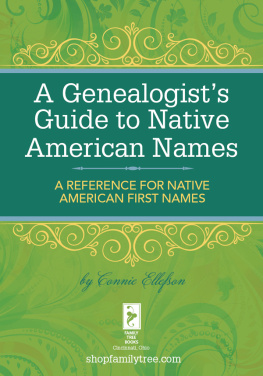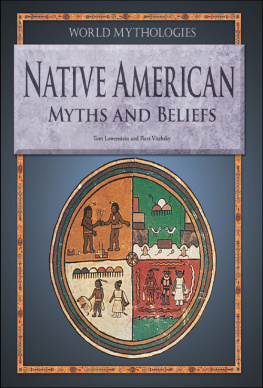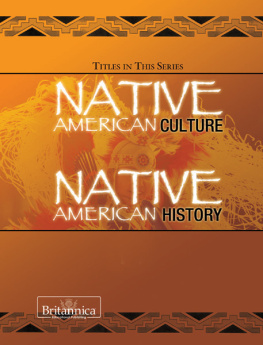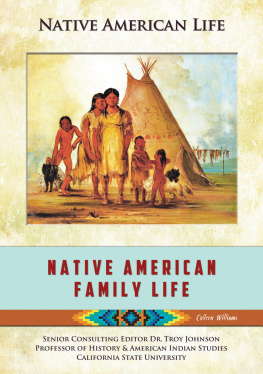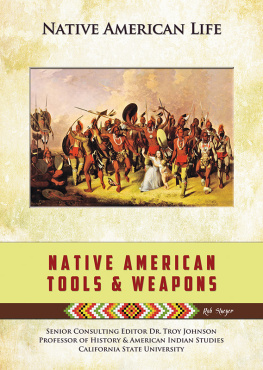EUROPEANS AND NATIVE AMERICANS
Jim Corrigan

NATIVE AMERICAN LIFE
E UROPEANS AND N ATIVE A MERICANS
H OMES OF THE N ATIVE A MERICANS
H UNTING WITH THE N ATIVE A MERICANS
N ATIVE A MERICAN C ONFEDERACIES
N ATIVE A MERICAN C OOKING
N ATIVE A MERICAN F AMILY L IFE
N ATIVE A MERICAN F ESTIVALS AND C EREMONIES
N ATIVE A MERICAN H ORSEMANSHIP
N ATIVE A MERICAN L ANGUAGES
N ATIVE A MERICAN M EDICINE
N ATIVE A MERICAN R ELIGIONS
N ATIVE A MERICAN R IVALRIES
N ATIVE A MERICAN S PORTS AND G AMES
N ATIVE A MERICAN T OOLS AND W EAPONS
W HAT THE N ATIVE A MERICANS W ORE
EUROPEANS AND NATIVE AMERICANS
Jim Corrigan

SENIOR CONSULTING EDITOR DR. TROY JOHNSON PROFESSOR OF HISTORY AND AMERICAN INDIAN STUDIES CALIFORNIA STATE UNIVERSITY

 | Mason Crest
450 Parkway Drive, Suite D
Broomall, PA 19008
www.masoncrest.com |
2014 by Mason Crest, an imprint of National Highlights, Inc.
All rights reserved. No part of this publication may be reproduced or transmitted in any form or by any means, electronic or mechanical, including photocopying, recording, taping, or any information storage and retrieval system, without permission from the publisher.
Printed and bound in the United States of America.
CPSIA Compliance Information: Batch #NAR2013. For further information, contact Mason Crest at 1-866-MCP-Book
First printing
1 3 5 7 9 8 6 4 2
Library of Congress Cataloging-in-Publication Data
Corrigan, Jim.
Europeans and native Americans / Jim Corrigan.
pages cm.(Native American life)
Includes bibliographical references and index.
ISBN 978-1-4222-2964-4 (hc)
ISBN 978-1-4222-8851-1 (ebook)
1. Indians of North AmericaFirst contact with EuropeansJuvenile literature.
2. Indians of North AmericaColonizationJuvenile literature. 3. AmericaDiscovery and explorationEuropeanJuvenile literature. I. Title.
E98.F39C67 2013
970.01dc23
2013007478
Native American Life series ISBN: 978-1-4222-2963-7
Frontispiece: Statue of Massasoit, the leader of the Wampanoag people, who helped colonists from Britain establish a settlement at Plymouth in the 1620s.
TABLE OF CONTENTS
For hundreds of years the dominant image of the Native American has been that of a stoic warrior, often wearing a full-length eagle feather headdress, riding a horse in pursuit of the buffalo, or perhaps surrounding some unfortunate wagon train filled with innocent west-bound American settlers. Unfortunately there has been little written or made available to the general public to dispel this erroneous generalization. This misrepresentation has resulted in an image of Native people that has been translated into books, movies, and television programs that have done little to look deeply into the Native worldview, cosmology, and daily life. Not until the 1990 movie Dances With Wolves were native people portrayed as having a human persona. For the first time, native people could express humor, sorrow, love, hate, peace, and warfare. For the first time native people could express them selves in words other than ugh or Yes Kemo Sabe. This series has been written to provide a more accurate and encompassing journey into the world of the Native Americans.
When studying the native world of the Americas, it is extremely important to understand that there are few universals that apply across tribal boundaries. With over 500 Nations and 300 language groups the worlds of the Native Americans were diverse. The traditions of one group may or may not have been shared by neighboring groups. Sports, games, dance, subsistence patterns, clothing, and religion differedgreatly in some instances. And although nearly all native groups observed festivals and ceremonies necessary to insure the renewal of their worlds, these too varied greatly.
Of equal importance to the breaking down of old myopic and stereotypic images is that the authors in this series credit Native Americans with a sense of agency. Contrary to the views held by the Europeans who came to North and South America and established the United States, Canada, Mexico, and other nations, some Native American tribes had sophisticated political and governing structuresthat of the member nations of the Iroquois League, for example. Europeans at first denied that native people had religions but rather worshiped the devil, and demanded that Native Americans abandon their religions for the Christian worldview. The readers of this series will learn that native people had well-established religions, led by both men and women, long before the European invasion began in the 16th and 17th centuries.
Gender roles also come under scrutiny in this series. European settlers in the northeastern area of the present-day United States found it appalling that Native women were treated as drudges and forced to do the mens work in the agricultural fields. They failed to understand, as the reader will see, that among this group the women owned the fields and scheduled the harvests. Europeans also failed to understand that Iroquois men were diplomats and controlled over one million square miles of fur trapping area. While Iroquois men sat at the governing counsel, Iroquois clan matrons caucused with tribal members and told the men how to vote.
These are small examples of the material contained in this important series. The reader is encouraged to use the extended bibliographies provided with each book to expand his or her area of specific interest.
Dr. Troy Johnson
Professor of History and American Indian Studies
California State University, Long Beach, California

This 19th-century illustration shows one of the most important events of American historyColumbus landing in the New World in 1492.
There was great excitement on that October day in the year 1492. People were running through the village, cheering and shouting as they ran toward the sea. The village chief, a man named Guacanagari, rushed out of his home and demanded to know what was causing the commotion. Three ships were approaching, he was toldthree large and mysterious ships. Even more amazing, a rumor was spreading that these ships had come from the sky! Guacanagari went back inside and put on his finest clothes. As chief, it would be his job to welcome the strangers and greet their captain, who might be a god.
There was also much excitement on board the three ships. The sailors had been at sea for weeks, and were thrilled by the sight of land. They had not come from the sky, as the villagers believed. They had come from Spain. And their captain was not a god; he was an Italian explorer named Christopher Columbus. Although he did not realize it at the time, Columbus had just arrived in what would come to be known as the New World.
Columbus had set sail from Spain with his three shipsthe Santa Maria, the Pinta, and the Niain search of a shorter route to Asia. He incorrectly assumed that the islands he approached were the East Indies, so he called the villagers who lived there Indians. In fact, Columbus was nowhere near Asia. He was actually in the Caribbean Sea, and the islands he had stumbled across are known today as the Bahamas, Cuba, and the Dominican Republic and Haiti. The native peoples he encountered were the Arawak and the Caribs. Even so, the name Indian is still widely used today to describe Native American people.
Next page


